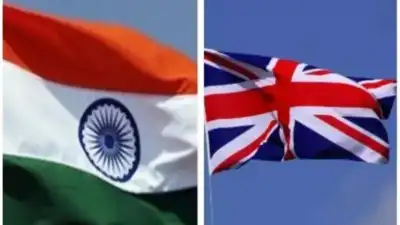India-UK Trade Deal: Full List of Indian States and Sectors That Will Benefit the Most from Tariff Cuts
Strategic Importance of the India-UK Trade Deal
The India-UK Trade Deal has emerged as one of the most anticipated international economic partnerships in recent years. Rooted in shared democratic values and centuries of historical ties, this bilateral agreement reflects the growing ambition of both nations to redefine global trade dynamics post-Brexit. As global markets become increasingly interlinked, the need for nations to carve out strategic alliances has never been more important. For India and the United Kingdom, this trade agreement is more than just a tariff-slashing exercise; it represents a long-term economic vision that fosters innovation, investment, and inclusive growth.
At the core of this deal lies the vision to unlock market access, reduce regulatory barriers, and enable smoother mobility of goods, services, capital, and skilled labor. India, with its rapidly growing economy and vibrant startup ecosystem, offers the UK a robust destination for investment and expansion. Conversely, the UK—with its strong financial services sector, technology, and premium education—is set to open new avenues for Indian businesses, professionals, and students.
India’s historical trade profile has always leaned heavily on partnerships with the US, the EU, and its Asian neighbors. But with the UK’s departure from the European Union, new opportunities have arisen to strengthen bilateral ties that were otherwise subject to EU regulations. This agreement aims to address long-standing trade bottlenecks such as double taxation, tariff escalation, intellectual property hurdles, and lack of mutual recognition of qualifications.
The strategic benefits go far beyond economics. For the UK, a successful deal with India is symbolic—it repositions Britain as a global trading nation, particularly in the Indo-Pacific, a region gaining increasing geopolitical significance. For India, this deal reaffirms its global standing and acts as a template for future FTAs with developed nations.
Tariff Reductions and Sector-Specific Benefits
One of the cornerstones of the India-UK Trade Deal is its emphasis on tariff reduction, a move that could significantly reshape the trade balance between the two countries. Tariff cuts are being meticulously structured to benefit both traditional and emerging sectors. The Indian textile and garment industry, a sector employing millions and contributing heavily to exports, stands to gain substantial market access under lower import duties in the UK. For consumers in Britain, this could mean more competitively priced Indian goods—especially clothing, jewelry, home furnishings, and leather products.
In return, India is offering tariff concessions to several UK-origin products including premium automobiles, Scotch whisky, and medical devices. The long-standing dispute over high import duties on Scotch whisky, which previously attracted tariffs of over 150%, is now being negotiated to lower rates, allowing British distillers better access to India’s large and evolving middle-class market. The automobile sector is also set to benefit, particularly brands like Jaguar Land Rover (owned by India’s Tata Motors), which may experience more seamless intra-brand logistics.
Agriculture and food processing sectors in both countries are also expected to receive a boost. Indian mangoes, basmati rice, and seafood exports will face fewer barriers entering the UK, while British dairy products and processed foods could find a niche among urban Indian consumers. Furthermore, this exchange could foster technological collaboration in agri-tech and sustainable farming practices.
The services sector—a stronghold for both nations—is poised for a revolution. India’s IT and professional service providers are expected to gain simplified work visa regulations, while the UK’s educational institutions and financial services will benefit from streamlined investment norms and increased recognition of British qualifications in India.
Overall, this chapter of the trade deal offers a compelling vision: one of economic complementarity, where both countries capitalize on each other’s strengths to fuel innovation, employment, and sustainable growth.
One of the most dynamic aspects of the India-UK Trade Deal lies in its provision for cross-border investments and the support it offers to startups and fintech ventures. India’s burgeoning startup ecosystem—the third largest in the world—has captured global attention for its innovation across sectors such as health tech, edtech, fintech, agritech, and logistics. Through this trade deal, UK venture capital firms, angel investors, and institutional partners will find a structured and less restrictive route into Indian markets.
The agreement proposes dedicated startup corridors, allowing early-stage companies from both nations to operate, co-develop products, and access cross-border funding with reduced regulatory burdens. Government-backed incubators and accelerators are also being positioned to support collaborative innovation. This is expected to particularly help in sectors such as clean energy, climate tech, AI, and cybersecurity, where both countries have mutual interests and complementary expertise.
On the financial services front, the deal aims to streamline processes around the entry and operation of banks, NBFCs, and insurance firms. For the UK, which hosts one of the world’s most prominent financial hubs—London—there is substantial interest in tapping into India’s growing demand for insurance penetration, digital lending, and capital management. India, on the other hand, is keen on attracting more financial institutions that can boost liquidity, compliance technology, and capital market depth.
Moreover, the deal includes mutual recognition of regulatory standards, easing compliance burdens and encouraging firms to expand operations without undergoing double certification or licensing. This applies particularly to sectors like accounting, auditing, and legal advisory, which have long faced non-tariff barriers in each other’s markets.
The financial collaboration doesn’t end at private enterprise. Government-backed financial cooperation—such as joint funds, sovereign investment partnerships, and technology-focused finance programs—are being proposed as long-term instruments of economic diplomacy. These instruments are aimed at de-risking capital flows and encouraging development finance in underserved regions of both nations.
Educational, Cultural, and Mobility Advantages
Beyond economics and technology, the India-UK Trade Deal also encompasses important provisions around education, cultural exchange, and skilled labor mobility. Education has always been a cornerstone of India-UK relations, with thousands of Indian students choosing the UK as a preferred destination for higher studies. The trade agreement now seeks to broaden this educational partnership by easing student visa requirements, expanding scholarship programs, and increasing bilateral research funding.
As part of the trade deal, the mutual recognition of educational qualifications will enable Indian students to access a wider array of UK professional certifications and licenses, which in turn will boost their employability in global markets. Simultaneously, British students and professionals looking to gain cultural, academic, or work exposure in India will face fewer bureaucratic hurdles, further diversifying educational collaboration.
Mobility provisions are equally transformative. Indian professionals working in sectors like information technology, finance, medicine, and engineering may benefit from relaxed visa norms, fast-track immigration services, and long-term work permits. These reforms are expected to reduce the talent bottleneck faced by UK industries while offering new opportunities for skilled Indian workers.
In addition to education and mobility, cultural exchange forms an integral part of this broader partnership. The deal outlines a roadmap for establishing cultural hubs, heritage festivals, co-productions in film and television, and collaborative art residencies. With a vast Indian diaspora already enriching British culture, these initiatives aim to build deeper people-to-people ties and reinforce soft power diplomacy.
By aligning the aspirations of students, professionals, and artists, the India-UK Trade Deal is laying the foundation for a more interconnected and culturally harmonious future. It signifies that international partnerships, when thoughtfully designed, can go beyond trade to transform lives and societies.
Education and skills development form a cornerstone of the India-UK Trade Deal. Both countries acknowledge the power of human capital and are investing in mechanisms that enable smoother movement of students, researchers, professionals, and skilled workers.
One of the most significant changes anticipated is the enhancement of student mobility. The UK remains a top destination for Indian students, with thousands enrolling annually in disciplines ranging from engineering and data science to business and humanities. The trade agreement aims to increase the number of scholarships, create credit transfer frameworks, and introduce a mutual recognition system for degrees and diplomas.
Further, work-study and post-study work visa durations are expected to be extended. This will allow Indian students to gain practical exposure in the UK and contribute to the host economy while acquiring valuable international experience. Likewise, British students will gain greater access to Indian universities and cultural exchanges, potentially with credits and internships attached.
From a workforce development standpoint, the deal paves the way for new skills corridors. These are sector-specific training and certification programs jointly designed by Indian and British institutions to upskill workers in areas like cybersecurity, climate science, AI/ML, healthcare, and electric mobility. These initiatives aim to address global talent shortages while enhancing employability for young professionals.
Research collaboration is also a focal point. Joint funding is being considered for collaborative projects between institutions like Oxford, Cambridge, IISc, and IITs. These projects will span cutting-edge fields like quantum computing, biotechnology, and sustainable architecture.
The mutual aim is clear: create an agile, educated, and mobile workforce that drives innovation and strengthens long-term bilateral ties.
India-UK Trade Deal delves into an area of mounting global concern: climate change and sustainability. Recognizing the urgency of environmental action, the agreement sets out clear frameworks for bilateral cooperation in reducing carbon footprints, transitioning to clean energy, and promoting green technologies.
A highlight of the deal is the commitment to facilitate joint R&D and technology transfer in areas such as solar energy, offshore wind, hydrogen fuel, carbon capture and storage, and electric mobility. The UK, with its experience in wind energy and climate policy, is expected to share best practices with Indian institutions and industries. India, in turn, will offer scale and implementation potential for pilot projects and next-generation green infrastructure.
Trade in environmental goods and services is another major focus. The deal includes provisions to reduce tariffs and non-tariff barriers on products such as solar panels, electric vehicles, energy-efficient appliances, and waste management systems. This move aims to foster competitive green markets, bring down the cost of eco-friendly alternatives, and enable sustainable urban planning in both countries.
The partnership also emphasizes climate finance. The UK’s financial institutions will collaborate with Indian partners to develop green bonds, sustainability-linked loans, and other instruments that mobilize capital for clean energy projects. A climate investment platform is under discussion to track, measure, and finance ESG-aligned initiatives.
Furthermore, the two nations are establishing joint task forces on water management, air quality control, and biodiversity conservation. Special attention is being paid to climate resilience in agriculture, disaster risk reduction, and sustainable urban mobility.
One of the standout features of the India-UK Trade Deal is its strong focus on labor mobility and people-to-people exchange, which represents a major breakthrough in how modern trade pacts go beyond goods and services to empower individuals and professions.
India’s young, skilled workforce has long been its comparative advantage. The trade agreement acknowledges this by formalizing new provisions for eased visa norms, mutual recognition of qualifications, and expanded work opportunities for professionals, students, and skilled labor across sectors.
The most significant step is the introduction of a new Skilled Professionals Mobility Framework, allowing easier movement of Indian professionals to the UK in fields such as:
- Information Technology
- Healthcare and Nursing
- Engineering
- Finance and Accounting
- Legal Services
- Architecture and Urban Planning
These pathways are intended to be streamlined, with reduced processing times and fewer bureaucratic hurdles. The UK has also agreed to expand the India Young Professionals Scheme, which permits Indian graduates to live and work in the UK for up to two years without employer sponsorship—fostering cultural exchange and early-career mobility.
Another highlight is the Mutual Recognition Agreement (MRA) between professional bodies of both countries. This is vital for sectors like law, medicine, and accounting, where licensing is often a barrier to cross-border practice. With MRAs in place, an Indian Chartered Accountant or Architect will have their credentials recognized in the UK and vice versa, unlocking transnational career growth.
In academia, the deal enables dual-degree programs, joint research fellowships, and credit transfer systems between Indian and UK universities. These measures not only benefit students but also fuel the broader knowledge economy of both nations.
Additionally, the trade deal includes a chapter on social safeguards, ensuring that increased labor mobility does not come at the cost of workers’ rights. It outlines protections for minimum wages, workplace safety, and grievance redressal in both countries.
By anchoring trade relations in human capital movement and professional growth, this agreement showcases a modern, inclusive model of globalization that aligns national interests with individual aspirations.
Also Read : Rajasthan Government School Collapse: Ignored Warnings Lead to Death of Seven Children








